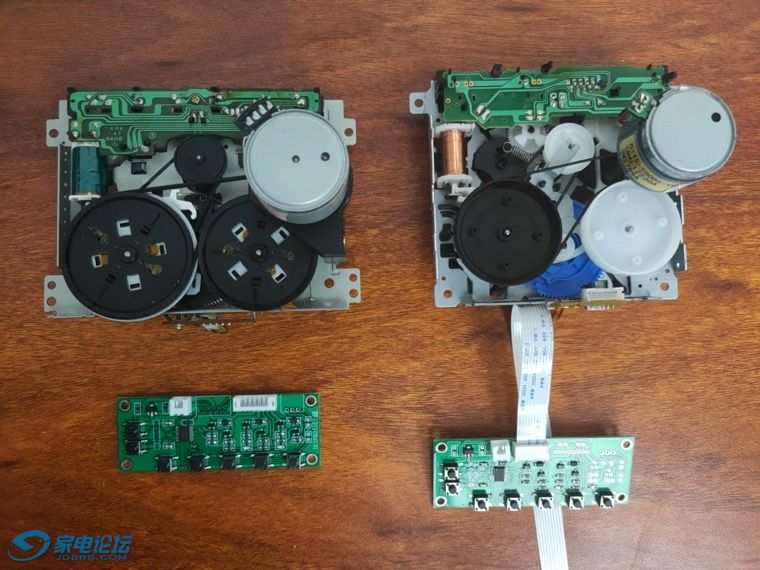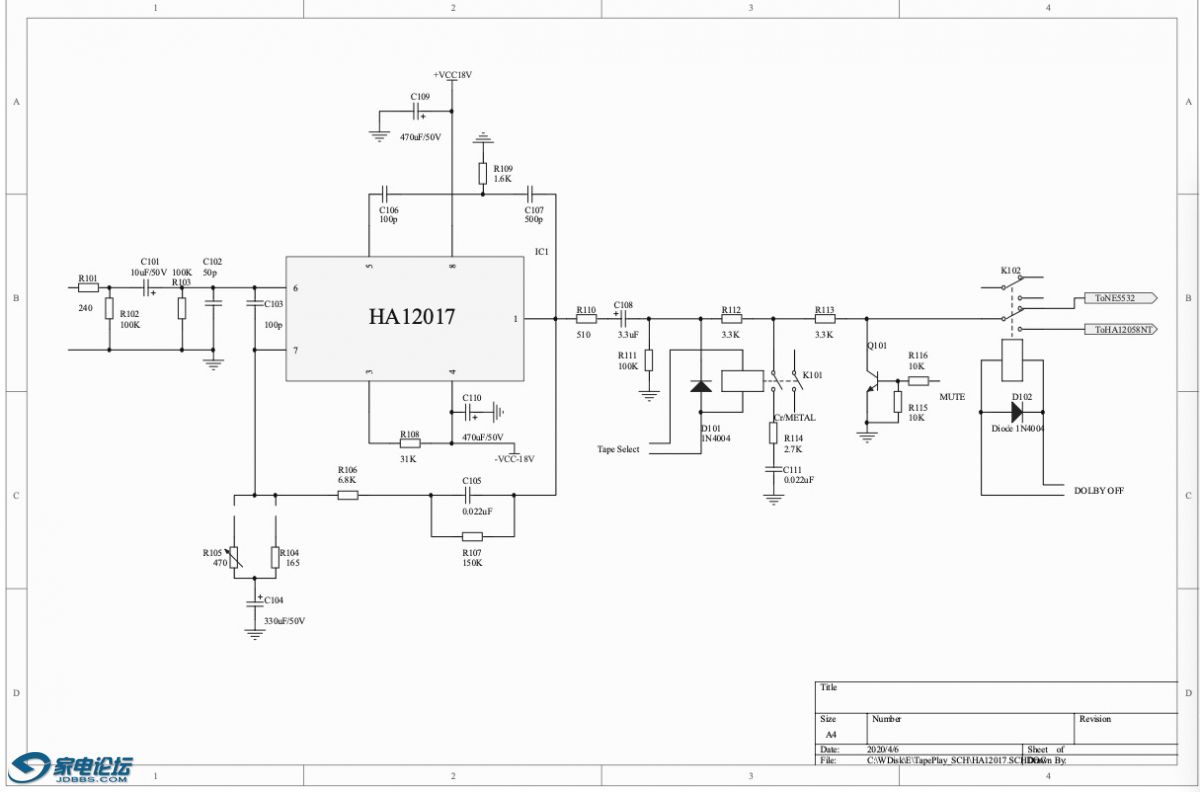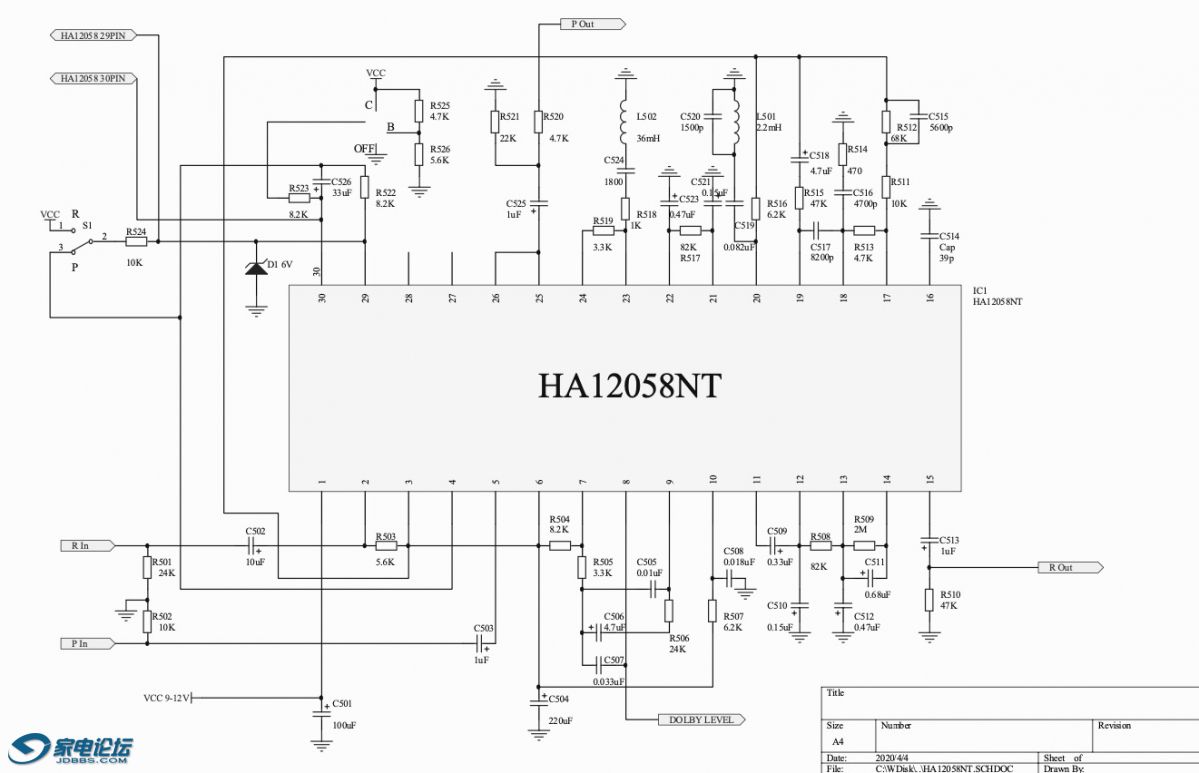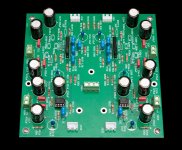Recently I buy a circuit board of an old DENON AMP,I broke tow HA12017 IC from the board.I decide to make a tape deck.The magnetic head Pre AMP use HA12017 IC and DOLBY B/C use HA12058 IC.
Now , the diagram of Pre AMP and the DOLBY B/C I complete design.
I buy tow new parts of tape deck, and control by CPU. NOW I begin to design PCB of tape deck.



Now , the diagram of Pre AMP and the DOLBY B/C I complete design.
I buy tow new parts of tape deck, and control by CPU. NOW I begin to design PCB of tape deck.



Interesting project. Note that HA12017 is not necessarily an ideal match for a tape head in terms of noise, depending on its inductance. We have discussed this part before. Now most tape heads seem to be in the 100-200 mH vicinity (although I've seen a mere 20 mH as well), so somewhat lower than a phono MM cartridge, but tendencies still seem to hold true - it's very hard to beat an NE5534A (or NJM2068, which performs rather similarly).
Since you already have the HA12017 circuit, I would suggest to insert an emitter follower or source follower in front of it. Find a relatively high-beta (~300-500 @ 100 µA) small-signal transistor without too much Rbb', or maybe a low-noise JFET (@1 mA) if you have any.
Top to bottom @ 1 kHz:
4558, LM833, NE5534A, LME49720, HA12017 (current noise estimated)

With follower added (BC550 ON Semi, 144 µA):

Note how the bare HA12017 comes in second to last for high-frequency noise, but with the follower added its low voltage noise allows it to take first place everywhere.
Schematics for LTspice attached.
BTW, I would also try to find some suitable flywheel weights. The plastic things seen there are pretty much a joke, especially in the mechanism on the right. That must have lousy wow & flutter.
Since you already have the HA12017 circuit, I would suggest to insert an emitter follower or source follower in front of it. Find a relatively high-beta (~300-500 @ 100 µA) small-signal transistor without too much Rbb', or maybe a low-noise JFET (@1 mA) if you have any.
Top to bottom @ 1 kHz:
4558, LM833, NE5534A, LME49720, HA12017 (current noise estimated)
With follower added (BC550 ON Semi, 144 µA):
Note how the bare HA12017 comes in second to last for high-frequency noise, but with the follower added its low voltage noise allows it to take first place everywhere.
Schematics for LTspice attached.
BTW, I would also try to find some suitable flywheel weights. The plastic things seen there are pretty much a joke, especially in the mechanism on the right. That must have lousy wow & flutter.
Attachments
Last edited:
Thanks for your detail explain HA12017 characteristic! 30 years ago,I make a tape deck using HA12017.at that time, the sound was better, and feel distortion was very low.but it was 30 years ago,I lose the tape head PreAMP and my memory is blur.Nnow I plan make it again according to HITACHI circuit,then improve sound depend on the shortcoming of play sound,I begin to buy all elements, tomorrow I start to draw PCB.
My computer and soft can not open the two attached files, can you attached picture file of circuit, thank very much!
Today,I complete design of power circuit diagram,I use tow transformer,the 50W transformer use for HA12017(tape head AMP)and NE5532(secondary AMP),and HA12058NT(DOLBY B/C),the three voltage regulation circuit,I use NE5532 for servo power.The other 30W transformer,I use for tape motor and CPU(control switch of some tape function),tomorrow I will begin to design PCB.


Attachments
hello.
this is deck controller, keys pcb ??
controlling mechanism - solenoid, photo sensor and swichs ?
Where CPU program HEX code ? Or is cpu out soldered deck motherboard ?
My is this left deck picture
this is deck controller, keys pcb ??
controlling mechanism - solenoid, photo sensor and swichs ?
Where CPU program HEX code ? Or is cpu out soldered deck motherboard ?
My is this left deck picture
hello.
I have designed several control boards of tape electronic control movement with MCU. 300 control boards have been sold in China, which are based on the principle of electromagnet, photoelectric switch and mechanical switch. Now I am still improving the circuit board
报错 笔记

I have designed several control boards of tape electronic control movement with MCU. 300 control boards have been sold in China, which are based on the principle of electromagnet, photoelectric switch and mechanical switch. Now I am still improving the circuit board
报错 笔记
I agree with sgrossklass that a Signetics NE5534 is just about the best IC for tape preamplification---in fact I have an Otari R-2-R deck that I REPLACED the HA12017s with 5534s.
And, in your power supply, I would opine that using a LM317/337 adjustable regulator will produce less noise than your 7918s.
And, in your power supply, I would opine that using a LM317/337 adjustable regulator will produce less noise than your 7918s.
Actually OPA2228 is better for the task and one more thing: you don't need +-15v supply for a tapehead preamp who's first stage usually has an output around 30..50mv...Today's op amps can do a supperb job at +-5v supply while the 90's standard was +-9 v as they needed to supply also the Dolby circuit.The less supply voltage, the less heat and subsequent noise, better current drive, less voltage offset, less dc voltage over the output capacitor, better distortion figure overall...From my personal experience i'd try using Pioneer CT-777 deck as a refference for the simplest preamp and nad 6300 or yamaha kx 990 as a two stage preamp before dolby next step.
The OPA2228 is a fine opamp, and has slightly less noise and distortion than an NE5534. But both of these parameters will be totally masked by the noise and distortion coming from the tape itself. The NE5534 is still faster and costs ONE-FIFTH of what an OPA2228 will cost.OPA2228 is better for the task
Before asking for a fast op amp in a tape playback circuit you better ask yourself if you want to amplify more of signal that passes the bias trap for the frequency usually found at 105khz.You actually want a very efective low pass filter for that part and the CMRR of opa2228 should be more effective in that respect.You should be happier with a circuit that's not able to amplify the tape hiss or what is picked up from the air by the tapehead itself.Many tapedecks have their bias oscillator unshielded or the tapehead itself exposed to emi . Some cheap decks have the motor regulator escaping a lot of noise into the rails and opa2228 PSRR is again spot on.The motor itself can leak out noise directly into the tapehead and the CMRR of 2228 is an advantage again.
And better ask yourself why at the peak of tapedeck era in the 90's to 2000 m5220, njm2068 and upc4570 was heavily preffered to ne5532 in many of the most expensive decks...
And better ask yourself why at the peak of tapedeck era in the 90's to 2000 m5220, njm2068 and upc4570 was heavily preffered to ne5532 in many of the most expensive decks...
- Home
- Source & Line
- Analogue Source
- I make a tape deck use HA12017 and HA12058


